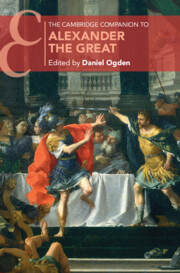Book contents
- The Cambridge Companion to Alexander the Great
- Cambridge Companions to the Ancient World
- The Cambridge Companion to Alexander the Great
- Copyright page
- Dedication
- Contents
- Figures
- Tables
- Maps
- Abbreviations
- Notes on Contributors
- Acknowledgements
- Introduction
- Part I Alexander’s Life and Career
- Part II Contexts
- Part III The Historical and Biographical Tradition
- Part IV The Ancient World’s Memory of Alexander
- 26 The Successors and the Image of Alexander
- 27 Alexander and The Roman Emperors
- 28 The Alexander Romance
- 29 Alexander in Jewish and Early Christian Literature
- 30 Alexander in Ancient Art
- Alexander’s Timeline 356–321 BC
- References
- Index
- Cambridge Companions to the Ancient World
26 - The Successors and the Image of Alexander
from Part IV - The Ancient World’s Memory of Alexander
Published online by Cambridge University Press: 04 January 2024
- The Cambridge Companion to Alexander the Great
- Cambridge Companions to the Ancient World
- The Cambridge Companion to Alexander the Great
- Copyright page
- Dedication
- Contents
- Figures
- Tables
- Maps
- Abbreviations
- Notes on Contributors
- Acknowledgements
- Introduction
- Part I Alexander’s Life and Career
- Part II Contexts
- Part III The Historical and Biographical Tradition
- Part IV The Ancient World’s Memory of Alexander
- 26 The Successors and the Image of Alexander
- 27 Alexander and The Roman Emperors
- 28 The Alexander Romance
- 29 Alexander in Jewish and Early Christian Literature
- 30 Alexander in Ancient Art
- Alexander’s Timeline 356–321 BC
- References
- Index
- Cambridge Companions to the Ancient World
Summary
The image of Alexander flourished across the disiecta membra of the empire he created and far beyond it. Consideration is given here to the appropriation of the king’s image in the broader sense – and principally through the medium of texts – in relation to the founders of the greater two of the Successor dynasties, those of the Ptolemies and the Seleucids. The legend of Seleucus was richly bathed in Alexander-imagery, and this imagery was focused, in different ways, on the person of Seleucus himself. Some of the tales focus syntagmatically on his personal interaction with the king, whilst he yet lived, and indeed in one case even after even he had died. Others serve to establish paradigmatic or typological parallel between the actions of Alexander and those of Seleucus, and some seek to do both. The case of Ptolemy is different: whilst there is again some focus on Ptolemy’s personal interaction with Alexander, much of the legend-generation focuses rather on Alexander’s relationship with Ptolemy’s city of Alexandria, the glory of which was the king’s tomb. So long as Ptolemy remained ensconced in the city, he could afford to bask in a more indirectly reflected variety of the king’s charisma.
- Type
- Chapter
- Information
- The Cambridge Companion to Alexander the Great , pp. 425 - 437Publisher: Cambridge University PressPrint publication year: 2024

